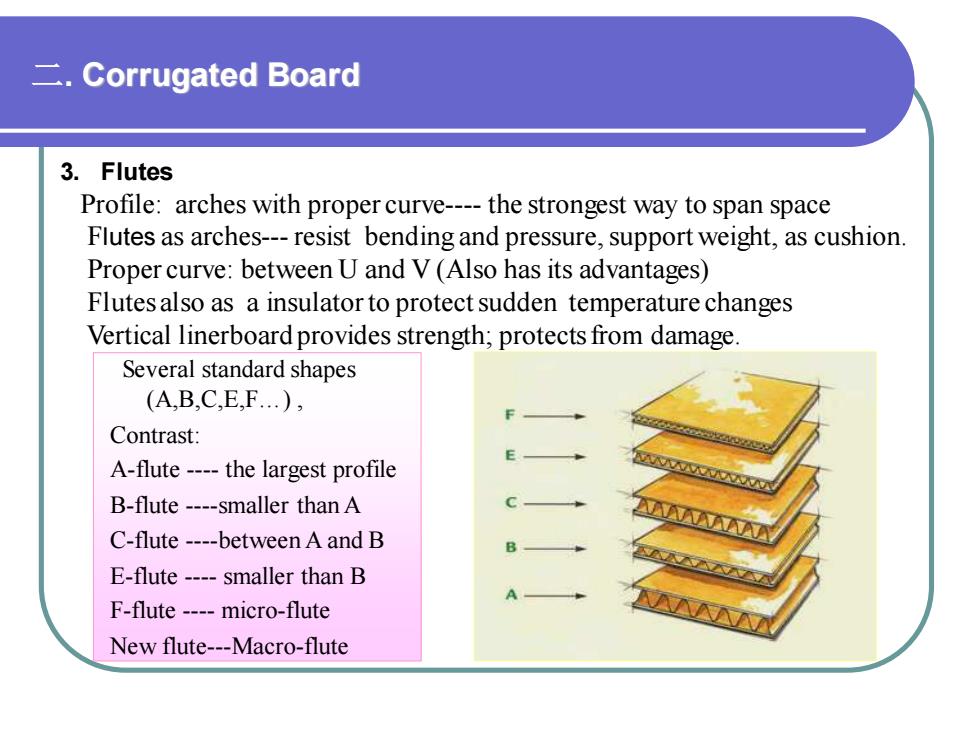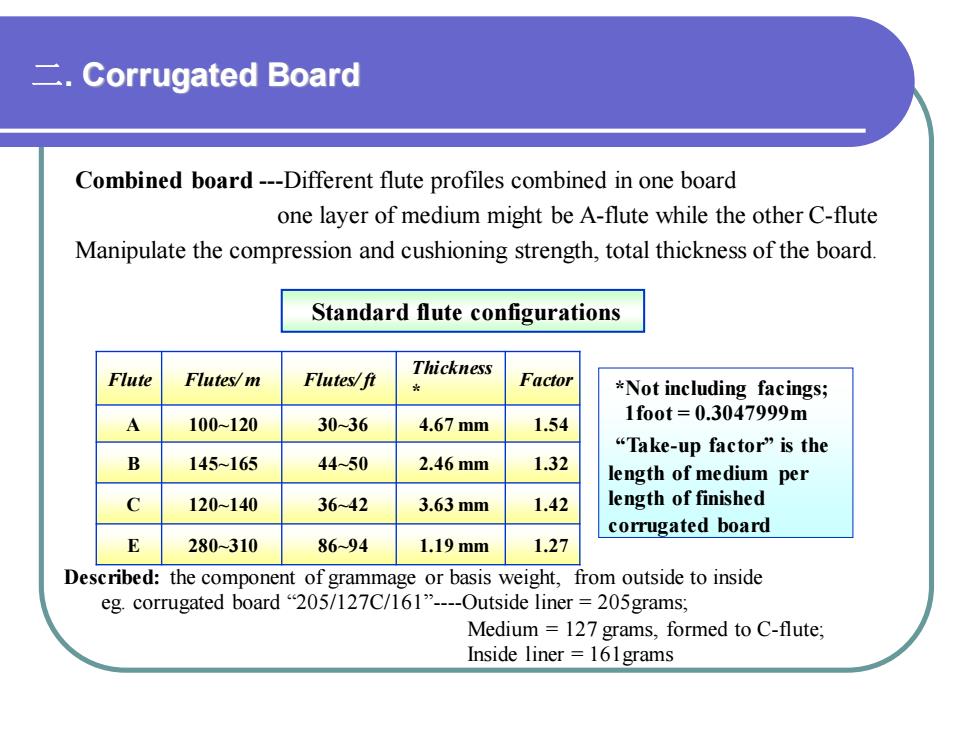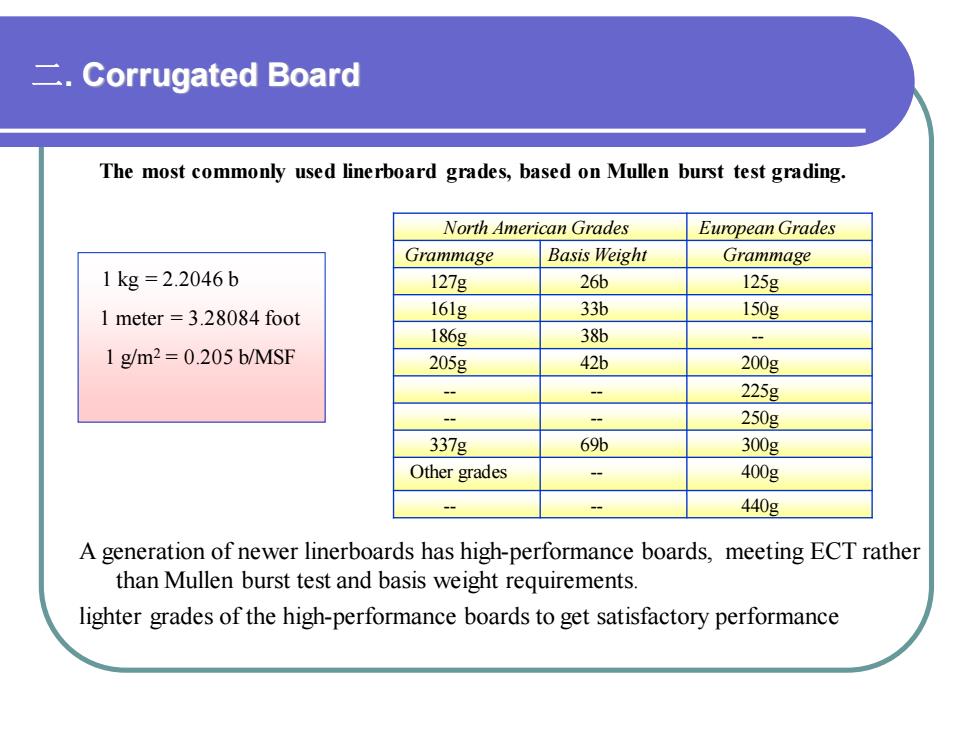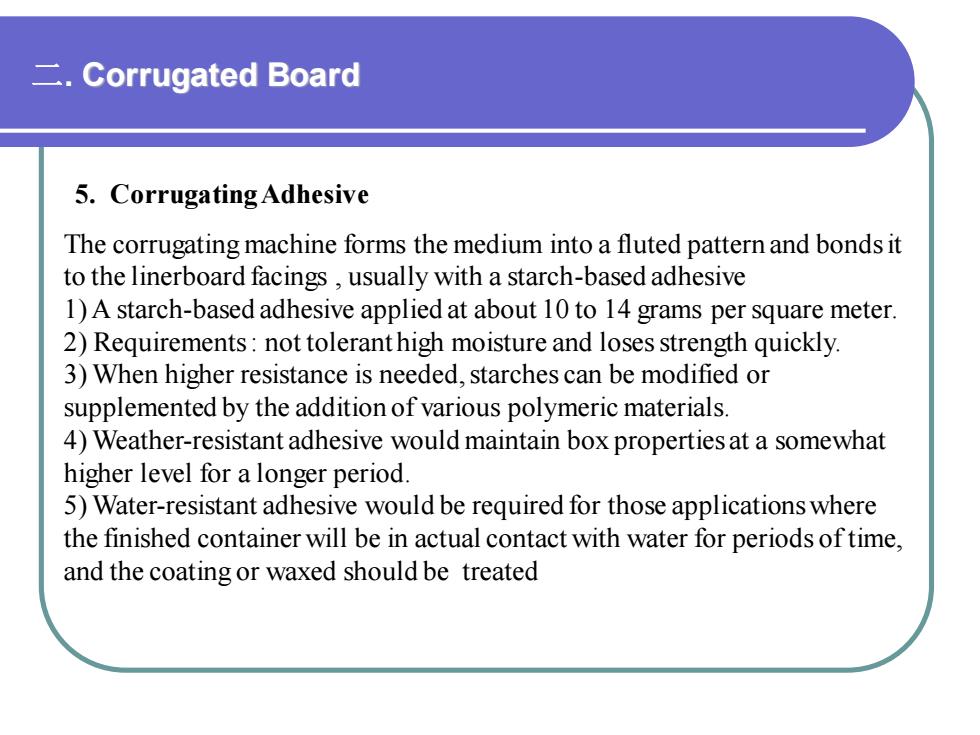
二. Corrugated Board 3. Flutes Profile: arches with proper curve- the strongest way to span space Flutes as arches- resist bending and pressure, support weight, as cushion. Proper curve: between U and V (Also has its advantages) Flutes also as a insulator to protect sudden temperature changes Vertical linerboard provides strength; protects from damage. Several standard shapes (A,B,C,E,F.) , Contrast: A-flute - the largest profile B-flute -smaller than A C-flute -between A and B E-flute - smaller than B F-flute - micro-flute New flute-Macro-flute
二. Corrugated Board 3. Flutes Profile: arches with proper curve- the strongest way to span space Flutes as arches- resist bending and pressure, support weight, as cushion. Proper curve: between U and V (Also has its advantages) Flutes also as a insulator to protect sudden temperature changes Vertical linerboard provides strength; protects from damage. Several standard shapes (A,B,C,E,F.) , Contrast: A-flute - the largest profile B-flute -smaller than A C-flute -between A and B E-flute - smaller than B F-flute - micro-flute New flute-Macro-flute

二. Corrugated Board Combined board -Different flute profiles combined in one board one layer of medium might be A-flute while the other C-flute Manipulate the compression and cushioning strength, total thickness of the board. Standard flute configurations Flute Flutes/ m Flutes/ ft Thickness * Factor A 100~120 30~36 4.67 mm 1.54 B 145~165 44~50 2.46 mm 1.32 C 120~140 36~42 3.63 mm 1.42 E 280~310 86~94 1.19 mm 1.27 *Not including facings; 1foot = 0.3047999m “Take-up factor” is the length of medium per length of finished corrugated board Described: the component of grammage or basis weight, from outside to inside eg. corrugated board “205/127C/161”-Outside liner = 205grams; Medium = 127 grams, formed to C-flute; Inside liner = 161grams
二. Corrugated Board Combined board -Different flute profiles combined in one board one layer of medium might be A-flute while the other C-flute Manipulate the compression and cushioning strength, total thickness of the board. Standard flute configurations Flute Flutes/ m Flutes/ ft Thickness * Factor A 100~120 30~36 4.67 mm 1.54 B 145~165 44~50 2.46 mm 1.32 C 120~140 36~42 3.63 mm 1.42 E 280~310 86~94 1.19 mm 1.27 *Not including facings; 1foot = 0.3047999m “Take-up factor” is the length of medium per length of finished corrugated board Described: the component of grammage or basis weight, from outside to inside eg. corrugated board “205/127C/161”-Outside liner = 205grams; Medium = 127 grams, formed to C-flute; Inside liner = 161grams

二. Corrugated Board 4 . Fiberboard Grades : Weight ; Thickness ; Material Grammage: the mass in grams per square meter. Basis weight: the weight in pounds per 1,000 square feet ( abbreviated lb/MSF). The most commonly used corrugating medium weights Grammage/g Basis Weight/b 127 26 147 30 161 33 195 40 Meterial : • Linerboard - natural kraft ;Solid bleached white kraft ; Mottled white ; Oyserboard Linerboard with a whiter surface provide better graphics. • Recycled or secondary fiber -producing both two components Recycled board -smoother surface finish ;low CoF; excellent printing surface
二. Corrugated Board 4 . Fiberboard Grades : Weight ; Thickness ; Material Grammage: the mass in grams per square meter. Basis weight: the weight in pounds per 1,000 square feet ( abbreviated lb/MSF). The most commonly used corrugating medium weights Grammage/g Basis Weight/b 127 26 147 30 161 33 195 40 Meterial : • Linerboard - natural kraft ;Solid bleached white kraft ; Mottled white ; Oyserboard Linerboard with a whiter surface provide better graphics. • Recycled or secondary fiber -producing both two components Recycled board -smoother surface finish ;low CoF; excellent printing surface

二. Corrugated Board The most commonly used linerboard grades, based on Mullen burst test grading. North American Grades European Grades Grammage Basis Weight Grammage 127g 26b 125g 161g 33b 150g 186g 38b - 205g 42b 200g - - 225g - - 250g 337g 69b 300g Other grades - 400g - - 440g 1 kg = 2.2046 b 1 meter = 3.28084 foot 1 g/m2 = 0.205 b/MSF A generation of newer linerboards has high-performance boards, meeting ECT rather than Mullen burst test and basis weight requirements. lighter grades of the high-performance boards to get satisfactory performance
二. Corrugated Board The most commonly used linerboard grades, based on Mullen burst test grading. North American Grades European Grades Grammage Basis Weight Grammage 127g 26b 125g 161g 33b 150g 186g 38b - 205g 42b 200g - - 225g - - 250g 337g 69b 300g Other grades - 400g - - 440g 1 kg = 2.2046 b 1 meter = 3.28084 foot 1 g/m2 = 0.205 b/MSF A generation of newer linerboards has high-performance boards, meeting ECT rather than Mullen burst test and basis weight requirements. lighter grades of the high-performance boards to get satisfactory performance

二. Corrugated Board 5. Corrugating Adhesive The corrugating machine forms the medium into a fluted pattern and bonds it to the linerboard facings , usually with a starch-based adhesive 1) A starch-based adhesive applied at about 10 to 14 grams per square meter. 2) Requirements : not tolerant high moisture and loses strength quickly. 3) When higher resistance is needed, starches can be modified or supplemented by the addition of various polymeric materials. 4) Weather-resistant adhesive would maintain box properties at a somewhat higher level for a longer period. 5) Water-resistant adhesive would be required for those applications where the finished container will be in actual contact with water for periods of time, and the coating or waxed should be treated
二. Corrugated Board 5. Corrugating Adhesive The corrugating machine forms the medium into a fluted pattern and bonds it to the linerboard facings , usually with a starch-based adhesive 1) A starch-based adhesive applied at about 10 to 14 grams per square meter. 2) Requirements : not tolerant high moisture and loses strength quickly. 3) When higher resistance is needed, starches can be modified or supplemented by the addition of various polymeric materials. 4) Weather-resistant adhesive would maintain box properties at a somewhat higher level for a longer period. 5) Water-resistant adhesive would be required for those applications where the finished container will be in actual contact with water for periods of time, and the coating or waxed should be treated